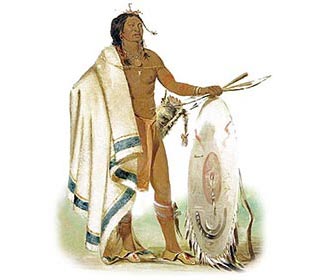Fast Facts about the History of Colorado Indians
The climate, land, history, environment and natural resources that were available to the indigenous Indian tribes in Colorado resulted in the adoption of the Southwest culture and some adopted the Great Plains Indians culture. - Name of State: Colorado
- Meaning of State name: The name is the Spanish word for "red" in reference to the color of the water of the Colorado River.
- Geography, Environment and Characteristics of the State of Colorado: Eastern dry high plains; hilly to mountainous central plateau; western Rocky Mountains of high ranges alternating with broad valleys and deep narrow canyons.
- Culture adopted by Colorado Indians: Southwest Cultural Group and some adopted the Great Plains. In the West Colorado area some adopted the Great Basin culture
- Languages: Southern Athabaskan (Apachean) language, Shoshonean or Uto-Aztecan
- Way of Life (Lifestyle): Farmers and some Nomadic hunters
- Types of housing, homes or shelters: Farmers lived in Adobe (pueblo) houses. Hunters lived in Hogans
History Timeline of the Colorado Indians - 10,000 BC: The first indigenous people were of the Paleo-Indian culture who lived in caves or were Nomadic Hunters
- 7000 BC: Archaic Period in which people built basic shelters and made stone weapons and stone tools
- 2500 BC: Gulf Formational Period with development of ceramics and pottery
- 1000 AD: Woodland period with permanent houses and farming
- 1300: Mississippian culture period of Mound builders
- 1500: Colorado is the homeland of the Ute Indian tribe
- 1682: French Explorer Rene-Robert Cavelier, Sieur de La Salle, claims Colorado for France
- 1765: The Spanish led by Juan Maria Rivera search for gold and silver
- 1775: 1775 - 1783 - The American Revolution.
- 1776: July 4, 1776 - United States Declaration of Independence
- 1803: The United States bought the Louisiana Territory from France for 15 million dollars for the land
- 1812: 1812 - 1815: The War of 1812 between U.S. and Great Britain, ended in a stalemate but confirmed America's Independence
- 1830: Indian Removal Act
- 1832: Department of Indian Affairs established
- 1848: Treaty of Guadalupe Hidalgo - Mexico cedes its land in Colorado to the United States
- 1860: Kiowa and Comanche expedition, Indian Territory. To remove the Kiowa and Comanche from the area of the Arkansas River.
- 1861: Congress establishes Colorado Territory
- 1861: 1861 - 1865: The American Civil War.
- 1863: Conflicts erupt between the white settlers and Plains Indians
- 1864: Sand Creek Massacre - Colonel John Chivington and his Colorado Volunteers massacred Cheyenne and Arapaho men, women, and children.
- 1862: U.S. Congress passes Homestead Act opening the Great Plains to settlers
- 1863: 1863-1869 War against the Cheyenne, Arapaho, Kiowa and Comanche Indians in Kansas, Nebraska (Territory), Colorado (Territory) and Oklahoma Indian Territory
- 1865: The surrender of Robert E. Lee on April 9 1865 signalled the end of the Confederacy
- 1865: Indian attacks intensify in Colorado
- 1868: Battle of Beecher Island, also known as the Battle of Arikaree Fork, was a conflict between the United States Army and several of the Plains native American tribes, including the Cheyenne Indians
- 1869: Battle of Summit Springs was the final military engagement between whites and plains Indians in Colorado
- 1876: Sioux and the Cheyenne joined forces and fought in the Battle of Little Bighorn in 1876 against General George Armstrong Custer on June 25, 1876
- 1881: Ute tribes are removed from Colorado onto Indian reservations
- 1887: Dawes General Allotment Act passed by Congress leads to the break up of the large Indian Reservations and the sale of Indian lands to white settlers
- 1915: The Bluff War, aka Posey War or the Polk and Posse War, Ute and Paiute and the US army. Location: San Juan County, Utah and Montezuma County, Colorado
- 1969: All Indians declared citizens of U.S.
- 1979: American Indian Religious Freedom Act was passed
History of Colorado Indians - Destruction and Decline
The history of the European invasion brought epidemic diseases such as tuberculosis, cholera, influenza, measles and smallpox. The Native Indians of Colorado had not developed immunities against these diseases resulting in huge losses in population. Exploitation including the leverage of taxes, enforced labor and enslavement were part of their history, taking their toll on the Colorado Indians. |
